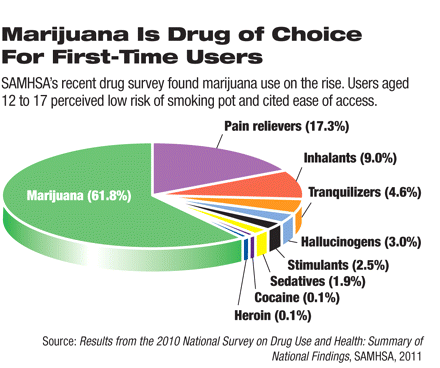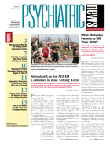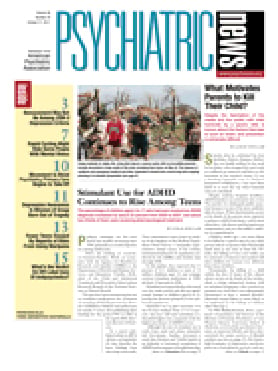Nearly 9 percent of the U.S. population aged 12 or older used illicit drugs in 2010, an increase over previous years that is due in large part to a rise in marijuana use. This is one of the key findings of the annual National Survey on Drug Use and Health (NSDUH) conducted by the Substance Abuse and Mental Health Services Administration (SAMHSA).
According to SAMHSA, the rate of illicit drug use rose only slightly from 2009 to 2010 (from 8.7 percent of the survey population to 8.9 percent), but these figures mark a steady and significant increase from the 8 percent usage rate of both 2007 and 2008. Between 2002 and 2006, the rate of illicit drug use remained relatively steady, fluctuating from a low of 7.9 percent to a high of 8.3 percent.
Similarly, while the percentage of those over age 12 who used marijuana last year (6.9 percent) was not much greater than the estimates for 2009 (6.6 percent), cause for concern lies in the incremental rise in marijuana usage rates that started at an eight-year low of 5.8 percent in 2007 and increased to 6.1 percent in 2008.
In total, 17.4 million of the 22.6 million individuals projected to have used illicit drugs in 2010 were marijuana users. And of the approximate 3 million new users of illicit drugs last year, the vast majority reported that their first drug was marijuana (see chart).
SAMHSA also noted several factors specifically related to the increased use of marijuana among those aged 12 to 17. The percentage of this cohort perceiving risk in smoking marijuana once or twice a week dropped from 49.3 percent in 2009 to 47.5 percent last year. Additionally, nearly half (48.6 percent) of the survey's youngest age group reported that it would be "fairly easy" or "very easy" for them to obtain the drug.
The survey also showed that marijuana use was far less prevalent among youth who said their parents would strongly disapprove of their trying the drug once or twice (4.4 percent) than for those who did not perceive strong parental disapproval (32.8 percent).
Among the report's other notable findings is that while the number of those misusing pain relievers for the first time has remained relatively constant over the past few years, 55 percent of these individuals reported receiving the medication for free from a friend or relative last year. This compares with 4.4 percent who said they obtained pain relievers from a drug dealer and 0.4 percent who purchased the medication on the Internet.
As in previous years, the 2010 survey also revealed a vast disparity between the number of individuals identified as needing specialty treatment for a substance abuse problem (23.1 million) and the number of those receiving such treatment (2.6 million). SAMHSA defines specialty treatment as the type made available at hospitals, drug or alcohol rehabilitation facilities, or mental health centers. It does not include treatment at a private doctor's office or in a self-help group, emergency room, or penal facility.
Areas of improvement identified in the survey include decreases in methamphetamine and cocaine use, as well as a drop in the drinking and tobacco smoking rates of youth aged 12 to 17.


